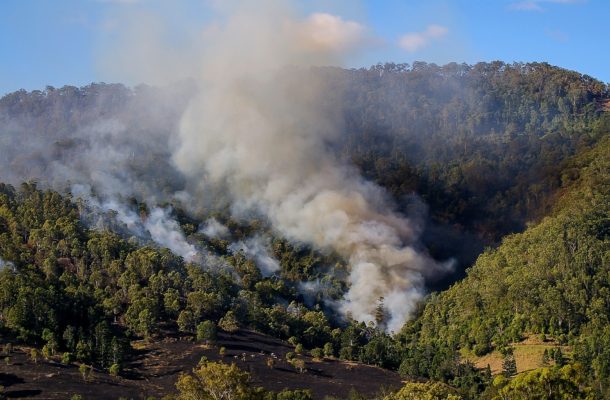The burning question for Australia’s politicians
Graeme McLeay | March 24, 2018

When is the right time to talk about the role of climate change in bushfires in Australia?
Malcolm Turnbull has accused Senator Richard Di Natale of a lack of empathy in making the connection between climate and bushfires following the late season bushfires in Victoria and NSW in recent days, saying now is not the time to “politicise” these terrible events.
Perhaps a true sense of empathy will lead to questioning how we manage the likelihood of a longer bushfire season, and more severe bushfires, as global warming continues.
The Bureau of Meteorology, the CSIRO, the National Oceanic and Atmospheric Administration in the United States and many other scientific bodies have warned that drier conditions and more extreme heat are to be expected, increasing the number and severity of bushfires.
Fortunately, no human lives have been lost in the latest round of bushfires. But the impacts have been enormous, with loss of houses, livelihoods, livestock and pets. The resulting stress can last for years and contribute to both mental and physical illness.
Health impacts can arise not only from the immediate threat of fire but also the effects of smoke containing particulates and volatile hydrocarbons which can lead to asthma, exacerbations of chronic lung disease and heart and vascular disease.
Australia’s contribution to climate change is small in absolute terms at around 1.5% but large in relative terms. Exported coal is not counted in Australia’s emissions but is a significant driver of climate change. With abundant wind and solar resources Australia’s very weak emissions reduction target of 26%-28% by 2030 is a clear indication of a government not taking climate change seriously.
Australia still has an electricity system dominated by coal and gas. Doctors for the Environment Australia and other health groups are asking when will health take its rightful place in energy policy? As The Lancet medical journal has pointed out, climate change and air quality are amongst the leading causes of non-communicable deaths worldwide.
Bushfires, also known as wildfires in the northern hemisphere, are part of that assessment.
Now we are being told that state based renewable energy targets must be abandoned in favour of the weak federal target and that the National Energy Guarantee will be the basis for combining climate and energy policy. Meanwhile, Australia’s emissions are climbing.
Storage technologies like pumped hydro and large and small-scale batteries make large amounts of renewable energy possible because they turn variable energy sources into dispatchable sources. The CSIRO and energy experts, including AEMO itself, have said there is no technical barrier to 100% renewable energy.
Climate Councillor and energy expert Andrew Stock said modelling by Ernst and Young “shows the NEG would result in almost no large scale wind and solar construction from 2020 onwards”. The modelling also revealed that there would be a loss of 20,000 jobs nationally in the renewables industry.
This is a consequence of Australia’s weak emissions reduction target. Coal-fired power stations around the country are aging and failing (Loy Yang B crashed in the January heatwave, taking out 528 MW and sending prices skyrocketing), and will have to be decommissioned as their useful life ends. Wind, solar and storage technologies are transforming energy supply around the world while Australia hangs on desperately to coal.
The federal government cannot merely continue to pay lip service to the Paris Agreement by adhering to its chosen target of 26%-28% reduction in emissions by 2030. While failing to join the global effort to hold global temperature increase to well below 2°C, the government is asking us to believe that there is no connection between burning fossil fuels and bushfires, drought, flooding and cyclones.
An admission of the role of climate change in bushfires will allow for adaptation for what is to come. Much more will be required in the way of resources and planning. Volunteer firefighters in small communities may not be able to cope and are at risk themselves.
If the tragedy of bushfires is to be diminished, a head in the sand attitude as to causes will not be enough. Empathy is needed but is no substitute for policy.
SHARE WITH:
Graeme McLeay is an Adelaide anaesthetist and a member of Doctors for the Environment Australia. In addition to his medical career, he is the author of a number of articles on pressing environmental issues.













Alan Stevenson
March 27, 2018 at 10:07 am
Maybe we should take note from history. The aborigines treated the land with respect, using fire when they thought necessary to clear the ground for better use. We tend to clear hundreds of acres for one type of crop, forgetting the rest of the environment. I have great respect for the attention to detail that the aborigines have to the land and its needs. Sure, we have to produce more food for the ever growing population of the world, but maybe we focus too much on profit and not enough on long-term management.
The story of the game reserve manager from South Africa who bought a farm in New South Wales springs to mind. He observed that the game ate a percentage of the fodder, then moved on. He introduced this practice into his farm by dividing it up into smaller allotments and constantly moving his cattle around. The result was that they did not eat the paddock completely; the grass remained strong and he could carry 25% more head per acre.
Amelia
March 27, 2018 at 10:18 am
The aborigines didn’t live in harmony with their environment, they exploited it with the technology they had just as ruthlessly as European settlers. They used fire for hunting which changed the landscape and hunted the megafauna into extinction. Australia once had huge flightless birds, wombats the size of cars, marsupial lions and nine foot tall Kangeroos. All gone. Some vanished soon after human arrival, others co-existed for thousands of years before growing human populations took their final toll, but this ‘noble savage’ view of Aborigine life does them a disservice. Just as the Māoris wiped out the Moas in New Zealand and early humans in the Americas wiped out the megafauna there, the first people in Australia wreaked havoc in environment just as surely as we are today.